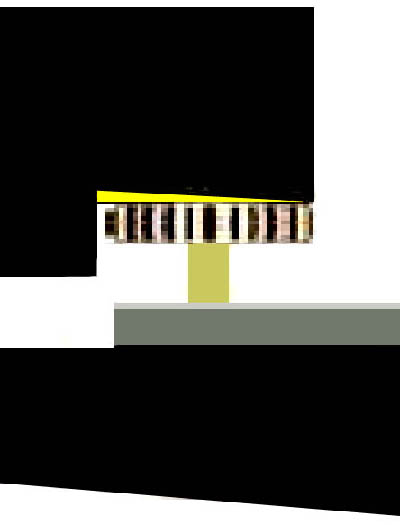| Some
thoughts about adjustable mandolin bridge setup
(also applies to
archtop guitar
bridges):
Above is your basic
adjustable bridge. A
vacuum fit is essential to good
sound transmission. We
assume its feet
have that vacuum fit to the top under
tension. If
the feet fit the top at
rest, understand that the top
will change shape under tension and that nice tight fit
will no longer
be perfect when it's strung up to pitch.
Here the top (AKA
saddle*) is
lowered all the way—the thumbwheels
are adjusted all the way down. Note the
remaining clearance
under the center of the top of the bridge.
What can you do to lower it further? Well...it would be best if you didn't have to do this, but if you are careful, you can cut away a bit of ebony from just above the thumbwheels so the center of the bridge drops lower and touches the base, like this:  If doing that means it's still not low enough, you can now begin lowering the top, which will entail recutting the compensation setbacks for the courses, and recutting grooves for the strings. This is often desirable anyway, but one thing at a time. Lowering a bridge like
this is semi-quick and dirty, but it works,
and has less
of a deleterious effect on the volume than you
might think. A lot of
Montana-era Flatiron
A-5s seem to have this issue - a less-than-ideal
neck angle resulting in a
bridge that can't be adjusted quite low enough. Ideally, one would reset
the neck so the
bridge could
remain tall and adjustable and its top remain
structurally strong. Let's look at this issue
again. Cracks happen. Wood is wood. There are limits to what one can do to avoid problems. That said, even nice tall bridge tops sometimes crack if the grain of the ebony isn't parallel to the flats of the thumbwheels. That sharp corner in the inside of the cutout where the cracks typically start creates a stress point and is a slight design flaw in the first place. Making the bridge from bad wood or at least wood with diagonal grain is a flaw in execution. If the action is pretty
close when the bridge
is adjusted
down fully, you can lower the action another final
bit by cutting the bridge top under
the wheels. However, if it becomes too thin, the
string pressure will
make the bridge swaybacked, overpowering
the wood,
and it will
crack:
At the very least, a
reduced bridge top will
not sound very good. And if you later have to
raise it up in order to
correct
the action, the string tension increases, and the
bridge top is even more
compromised. Steve Smith at Cumberland
Acoustics makes a "Lo-Boy" bridge that has a lower
base so that the top remains more robust.
If you can keep enough wood above the thumbwheels, it's possible to take a little bit off the underside of the ebony above the wheels to exert slight pressure on the outside of the wheels themselves, like this:  
Don't
underestimate the string tension! The
ideal situation
is to leave a good bit of wood in the top (or
saddle) of the bridge -
it transmits sound better, and it won't sag.
|



